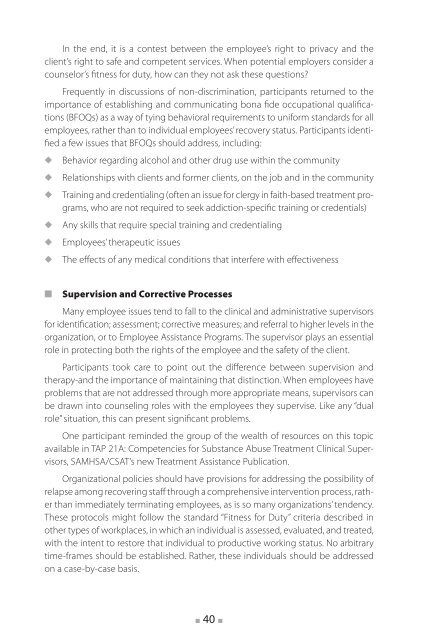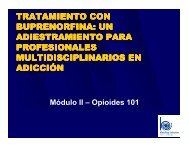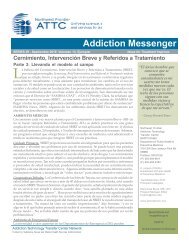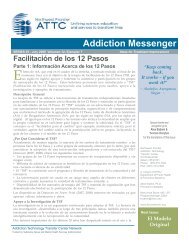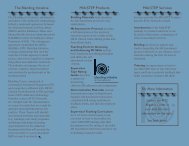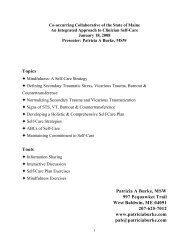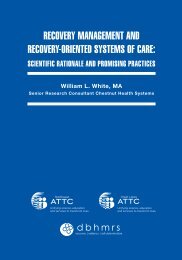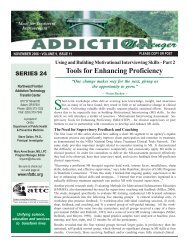alcohol and other drug problems among addiction professionals
alcohol and other drug problems among addiction professionals
alcohol and other drug problems among addiction professionals
You also want an ePaper? Increase the reach of your titles
YUMPU automatically turns print PDFs into web optimized ePapers that Google loves.
In the end, it is a contest between the employee’s right to privacy <strong>and</strong> theclient’s right to safe <strong>and</strong> competent services. When potential employers consider acounselor’s fitness for duty, how can they not ask these questions?Frequently in discussions of non-discrimination, participants returned to theimportance of establishing <strong>and</strong> communicating bona fide occupational qualifications(BFOQs) as a way of tying behavioral requirements to uniform st<strong>and</strong>ards for allemployees, rather than to individual employees’ recovery status. Participants identifieda few issues that BFOQs should address, including:◆ Behavior regarding <strong>alcohol</strong> <strong>and</strong> <strong>other</strong> <strong>drug</strong> use within the community◆ Relationships with clients <strong>and</strong> former clients, on the job <strong>and</strong> in the community◆ Training <strong>and</strong> credentialing (often an issue for clergy in faith-based treatment programs,who are not required to seek <strong>addiction</strong>-specific training or credentials)◆ Any skills that require special training <strong>and</strong> credentialing◆ Employees’ therapeutic issues◆ The effects of any medical conditions that interfere with effectivenessnSupervision <strong>and</strong> Corrective ProcessesMany employee issues tend to fall to the clinical <strong>and</strong> administrative supervisorsfor identification; assessment; corrective measures; <strong>and</strong> referral to higher levels in theorganization, or to Employee Assistance Programs. The supervisor plays an essentialrole in protecting both the rights of the employee <strong>and</strong> the safety of the client.Participants took care to point out the difference between supervision <strong>and</strong>therapy-<strong>and</strong> the importance of maintaining that distinction. When employees have<strong>problems</strong> that are not addressed through more appropriate means, supervisors canbe drawn into counseling roles with the employees they supervise. Like any “dualrole” situation, this can present significant <strong>problems</strong>.One participant reminded the group of the wealth of resources on this topicavailable in TAP 21A: Competencies for Substance Abuse Treatment Clinical Supervisors,SAMHSA/CSAT’s new Treatment Assistance Publication.Organizational policies should have provisions for addressing the possibility ofrelapse <strong>among</strong> recovering staff through a comprehensive intervention process, ratherthan immediately terminating employees, as is so many organizations’ tendency.These protocols might follow the st<strong>and</strong>ard “Fitness for Duty” criteria described in<strong>other</strong> types of workplaces, in which an individual is assessed, evaluated, <strong>and</strong> treated,with the intent to restore that individual to productive working status. No arbitrarytime-frames should be established. Rather, these individuals should be addressedon a case-by-case basis.n 40 n


